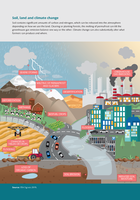
The calculations of GHG emission trends, projections and targets include emissions from international aviation and exclude emissions and removals from the LULUCF sector. The 'with existing measures' scenario reflects existing policies and measures, whereas the 'with additional measures' scenario considers the additional effects of planned measures reported by Member States.

Historic trends from 1990 to 2017 are represented in solid lines. Projections until 2035 are represented in dashed lines. The upper line represents the scenario "with existing measures", while the lower line represents the scenario "with additional measures". EU targets and objectives for 2020, 2030 and 2050 are represented as bullets.

Soil contains significant amounts of carbon and nitrogen, which can be released into the atmosphere depending on how we use the land. Clearing or planting forests, the melting of permafrost can tilt the greenhouse gas emission balance one way or the other. Climate change can also substantially alter what farmers can produce and where.

Several EU targets have been set to reduce the environmental impacts of transport in Europe, including its greenhouse gas. The transport sector’s targets are part of the EU’s overall goal to reduce greenhouse gas emissions by 80 – 95 % by 2050.

Each bar represents a national target for greenhouse gas emissions which are covered under the Effort Sharing Decision (i.e. not covered under the EU Emissions Trading System). Targets are annual for the period from 2013 until 2020. The graph represents the 2013 and 2020 targets.

Several EU targets have been set to reduce the environmental impacts of transport in Europe, including its greenhouse gas emissions. The transport sector’s targets are part of the EU’s overall goal to reduce greenhouse gas emission by 80-95% by 2050.

Data compiled by EEA. At EU level, the data provided are total greenhouse gas (GHG) emissions (excluding emissions from LULUCF, including emissions from international aviation), which are consistent with the emission scope covered in the EU’s objective to reduce its GHG emissions by 20% compared to 1990 by 2020. At Member State level, the data provided are ‘non-ETS emissions’ (emissions covered under the ‘Effort Sharing Decision’ (406/2009/EC)). The Effort Sharing Decision sets national annual binding targets for emissions not covered under the EU emission trading scheme (ETS). These non-ETS emissions exclude emissions from LULUCF, emissions from international aviation and CO2 emissions from domestic aviation.

The figure illustrates the net emission reduction achieved in the period 1995-2008 (in the first column) and the net GHG emission reductions in 2020 compared to 1995 for all three scenarios (in columns two, three and four). The net emission reduction is calculated as the difference between net emissions in 1995 and net emissions in 2008 or 2020, as appropriate.

This figure identifies the net emission in CO2 equivalents for the treatment of 1 tonne of kitchen and garden waste for each of the 5 treatment options: landfilling, incineration, composting, home composting and anaerobic digestion. The average EU treatment mix in 2008 is also included.

This figure identifies the net greenhouse gas (GHG) emission from the management of municipal solid waste (MSW) from 1990 to 2020. Emissions from the waste management are split into different treatment options (recycling, incineration, landfilling and transportation) and into direct and avoided emissions.

Based on preliminary estimates and calculations by EEA. Data may change in 2012 pending on the publication of 2012 GHG emission inventories and on further comments from Member States concerning ETS scope corrections.
Progress calculated based on domestic emissions only, without accounting for possible use of flexibilities. Relative gaps estimated by dividing the difference between projected non‑ETS 2020 emissions and estimates of 2020 targets under the Effort Sharing Decision by EEA estimates of 2005 non‑ETS emissions (for a scope consistent with the 2013–2020 period, i.e. taking into account the changes in scope of the EU ETS, in particular installations opted out in 2005 and included in the ETS in 2008–2012, and the extension of the ETS scope from 2013 onwards).


Document Actions
Share with others